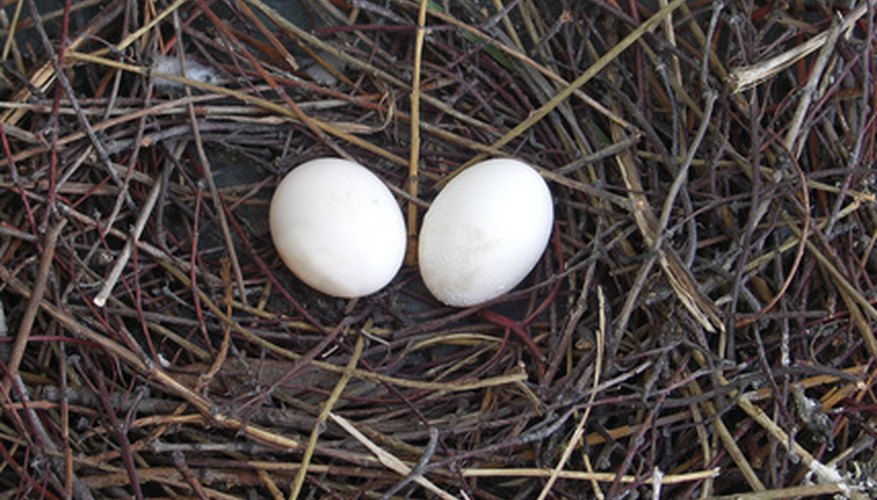The characteristics of bird eggs can give clues about the species that laid them. Although there are a number of white bird eggs, there are other distinguishing characteristics that can lend themselves to species identification. The nest can also play a role in the identification of white bird eggs, as birds use a wide variety of different materials to craft their nests.
Colour
Most birds that lay white eggs lay their eggs in enclosed spaces, while coloured eggs are typically laid in more open spaces. Many white eggs are not completely white, and this plays a role in identifying the species that laid them. Some bird species can lay white eggs even when their eggs are normally coloured, including the eastern bluebird and the mountain bluebird. Some eggs are white-to-cream in colour, such as the black-capped chickadee and the ash-throated flycatcher. There are only a few species that lay completely pure white eggs, such as the tree swallow, oak titmouse and the purple martin.
- Most birds that lay white eggs lay their eggs in enclosed spaces, while coloured eggs are typically laid in more open spaces.
- Some bird species can lay white eggs even when their eggs are normally coloured, including the eastern bluebird and the mountain bluebird.
Texture
Some birds lay smooth-textured eggs, such as the eastern bluebird and the ash-throated flycatcher. Some white eggs are glossy, like those of the mountain bluebird and the purple martin, while others have little to no gloss at all, such as the Carolina chickadee and the violet-green swallow. The brown-headed cowbird lays eggs that have granulated shells. Some eggs are noticeably thin-shelled, such as the black-capped chickadee egg.
- Some birds lay smooth-textured eggs, such as the eastern bluebird and the ash-throated flycatcher.
- Some white eggs are glossy, like those of the mountain bluebird and the purple martin, while others have little to no gloss at all, such as the Carolina chickadee and the violet-green swallow.
Size
Size can play an important role in egg identification among different species. The brown-headed cowbird and house sparrow have similarly shaped and coloured eggs, but the cowbird's egg is noticeably larger. Compare the size of the egg you are identifying to common bird sizes. Is the egg large, like a chicken's egg, or small, like a robin's egg?
- Size can play an important role in egg identification among different species.
- The brown-headed cowbird and house sparrow have similarly shaped and coloured eggs, but the cowbird's egg is noticeably larger.
Markings
Markings can also play a role in egg identification, as very few eggs are pure white. The brown-headed nuthatch lays an egg that is smooth and white with brown dots, spots and blotches distributed evenly across it. The pygmy nuthatch has a similar egg with purplish markings and speckles across it. Warbler eggs are blotched and spotted boldly with purple and brown spots across the entire egg. Pay attention to any distinctive marks on the egg to help identify the species that laid it.
- Markings can also play a role in egg identification, as very few eggs are pure white.
- The pygmy nuthatch has a similar egg with purplish markings and speckles across it.
Nest
In addition to the characteristics of the egg, the habitat where the eggs are found can also lend to their identification. Pay close attention to the type of nest and what materials are used in its creation. Some birds create intricate nests, while others simply lay their eggs in thick brush or reeds. House sparrows, house wrens, bluebirds and tree swallows lay their eggs in visible places, whereas titmice and chickadees hide their eggs well. Some birds will nest with nearly any material, such as the white-breasted nuthatch, which is known to use cigarette butts as nesting material.
- In addition to the characteristics of the egg, the habitat where the eggs are found can also lend to their identification.
- Some birds will nest with nearly any material, such as the white-breasted nuthatch, which is known to use cigarette butts as nesting material.
